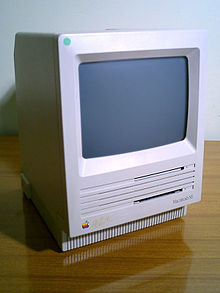Macintosh SE
The Macintosh SE was a popular computer model from Apple . It was introduced in March 1986 and was part of the program until October 1990.
Although it was partly produced in parallel with the Macintosh Plus , it was its successor. Compared to this, there was a new housing design, whereby the concept of the all-in-one housing (computer, monitor, hard disk and floppy disk drive in one housing, external keyboard and mouse) was retained. The case was in the new platinum color (a very light shade of gray) that was introduced with the Macintosh Plus. However, due to the optional internal hard disk and the possibility of installing expansion cards, a fan on the back was necessary to cool the housing through increased air circulation.
Like the Plus, the Macintosh SE has a Motorola 68000 with 8 MHz, a 9 inch b / w screen with 512 × 342 pixels, but compared to the Macintosh Plus has faster access to the main memory (approx. 15%) and an SE-PDS expansion slot for monochrome graphics cards for full-screen monitors, Ethernet cards, GPIB or CPU cards as well as an internal SCSI connection. Thus the Macintosh SE was prepared for an internal SCSI hard disk, typically 20 or 40 MB were shipped from the factory. In contrast to the ENIAC, the first computer that only managed 3 square roots per second, the Macintosh SE is 24 times faster with 72 square roots per second.
The main memory is expanded via four 30-pin SIMM sockets and amounts to a maximum of 4 MB.
Mac OS systems from version 2.0 to 7.5.5 and Minix run on the Macintosh SE .
In 1989 the Mac SE in the dual-floppy configuration cost 6400 DM, with a hard drive even 7600 DM. The last remaining stock was sold as a student version for 1200 DM. The successor to the SE was the Macintosh Classic , which also had a Motorola 68000/8.
See also: Macintosh models
Web links
- knubbelmac.de
- myoldmac.net WebSE - System 7.0 simulation
- www.oldmac.de
